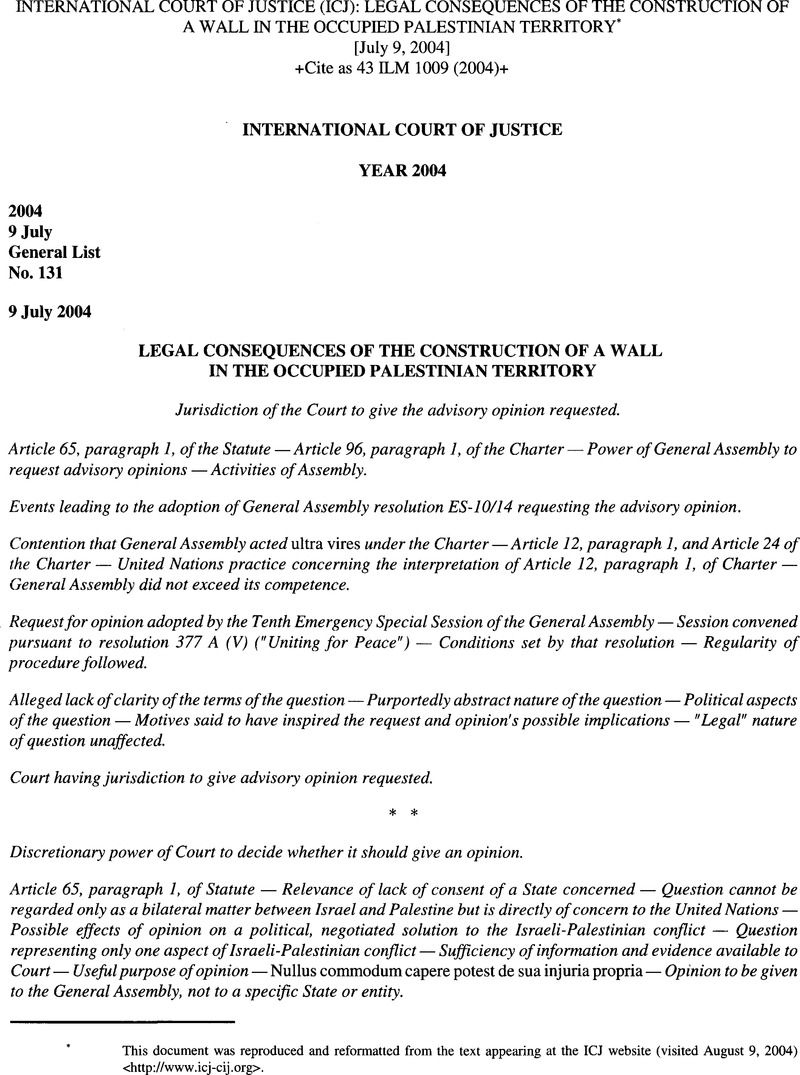Published online by Cambridge University Press: 27 February 2017

* This document was reproduced and reformatted from the text appearing at the ICJ website (visited August 9, 2004)<http://www.icj-cij.org.=
1 United Nations, Treaty Series, Vol. 75, No. 973.
2 Ibid., Vol. 1125, No. 17512.
3 See Carnegie Endowment for International Peace, The Hague Conventions and Declarations of 1899 and 1907 (New York, Oxford University Press, 1915).
4 E/CN.4/2004/6.
5 A/ES-10/248.“
1 Report of the Secretary-General prepared pursuant to General Assembly resolution ES-10/2 of 25 April 1997, para. 21, A/165-10/6- S/1997/494.
2 Sir Arthur Watts, CR 2003/3, p. 64.
1 No. 181 (II), resolution adopted on the report of the Ad Hoc Committee on the Palestinian Question (29 November 1947), Chap. 4, para. 2.
2 Ibid.
3 Preamble, CMD. No. 1785 (1923), reprinted in report of the United Nations Special Committee on Palestine (UNSCOP report).
4 Covenant of the League of Nations, Article 22.
5 Laws of the State of Israel, Vol. I, p. 3.
6 Moreover, Judge Weeramantry, in his dissenting opinion in the East Timor case, considered that “a resolution containing a decision within its proper sphere of competence may well be productive of legal consequences” (East Timor (Portugal v. Australia), I. C.J. Reports 1995, p. 186; emphasis added).
7 Greenwood, C., “The Administration of Occupied Territory in International Law”, International Law and the Administration of Occupied Territories, (Ed. by E. Playfair, Clarendon Press, Oxford, 1992), pp. 262–263.Google Scholar
8 Ibid.
9 Falk, &Weston, , “The Relevance of International Law to Israeli and Palestinian Rights in the West Bank and Gaza”, International Law and the Administration of Occupied Territories (ed. by E. Playfair, Clarendon Press, Oxford, 1992), Chap. 3, pp. 146–147.Google Scholar
10 Schmitt, M. N., “Bellum Americanum: The U.S. View of Twenty-First Century War and its Possible Implications for the Law of Armed Conflict” (1998), 19 Michigan Journal of International Law, p. 1080.Google Scholar
1 See, in particular, Michla Pomerance, The Advisory Function of the International Court in the League and U.N. Eras (1973) at p. 9.
2 Ibid., at p. 14.
3 Article 17 of the Covenant provides: “In the event of a dispute between a Member of the League and a State which is not a Member of the League, or between States not Members of the League, the State or States not Members of the League shall be invited to accept the obligations of membership in the League for the purposes of such dispute, upon such conditions as the Council may deem just. If such invitation is accepted, the provisions of Articles 12 to 16 inclusive shall be applied with such modifications as may be deemed necessary by the Council.”
4 Michla Pomerance, op. cit. , at p. 281.